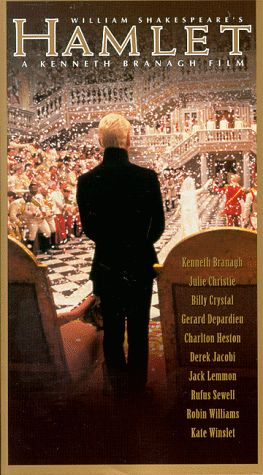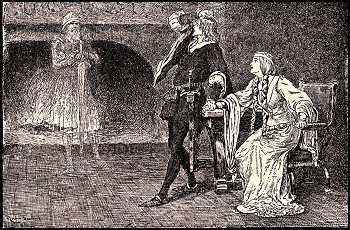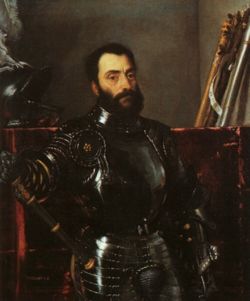SCENE i
Claudius and Gertrude have a conflab with Rosencrantz and Guildenstern. Claudius clearly senses something ominous in Hamlet's "turbulent and dangerous lunacy" (III.i.4), but R & G report that he's being too crafty and aloof for them to detect the cause. Claudius seems glad about Hamlet's enthusiasm for the players -- at least the boy has a hobby to keep him occupied. Claudius dismisses Frick and Frack, and Gertrude too, so that he and Polonius can hide and spy on Hamlet's interaction with Ophelia. Polonius tells her exactly where to stroll and to pretend to read a book. Claudius, in an aside, acknowledges that he is tormented by an unspecified guilt.
Hamlet's "To be or not to be" soliloquy (III.i.55ff) -- expressing an outlook directly influenced by Cardanus Comforte (Anderson 64) -- debates the desirability of oblivion in light of human misery. "It seems to be a meditation on suicide, and Hamlet feels that everyone would kill himself and escape this miserable world, if only he were sure that some unknown and more frightful horror did not await him in the afterworld" (Asimov 118). The soliloquy "has become the hallmark of interiority and consciousness, the speech that -- quoted, parodied, parsed, and pondered -- has come to define modernity and modern self-consciousness, the birth, in effect, of the modern subject, of modern subjectivity itself" (Garber 475). Traditionally, Hamlet has been accused of melancholic procrastination (as in the Olivier film's unwelcome introductory assertion that the story is about "a man who could not make up his mind"), but Hamlet is also morally scrupulous. This soliloquy can be read as a regression to the first one, but there is no easy Christian dismissal of suicide this time; here it's a matter of the imprisonment of hyperconsciousness -- something one is likely not to escape even after "we have shuffled off this mortal coil" (III.i.66). So where can one find peace if not in the oblivion of "The undiscover'd country" (III.i.78)? That's legitimately worrisome. "Thus conscience does make cowards of us all" (III.i.82).
Ophelia insists that Hamlet take back his love letters to her, "for to the noble mind / Rich gifts wax poor when givers prove unkind" (III.i.99-100). Hamlet no doubt catches the Polonian tone and influence in that adage, or platitude, and realizes she's now thoroughly a puppet for daddy. He rants at her, commanding, "Get thee to a nunn'ry, why wouldst thou be a breeder of sinners?" (III.i.120) and making her believe "O, what a noble mind is here o'erthrown!" (III.i.150).
In light of this extreme behavior, upon which Claudius and Polonius have eavesdropped, Polonius still insists Hamlet's madness is "Sprung from neglected love" (III.i.178), but Claudius is obviously worried there's more and decides that Hamlet must be sent to England. "England had been paying tribute to Danish raiders ever since 991.... Such tribute was called the 'Danegeld'" (Asimov 120). Polonius proposes another spying session: he'll eavesdrop on a private conversation arranged between Hamlet and Gertrude. Claudius approves of this idea, since "Madness in great ones must not unwatch'd go" (III.i.188).
Here's a reading of the play that strikes a familiar chord to those of us who have been jerked around by scumbags with power.
Those who mistake their roles for their total real identity can understand neither themselves nor others. Since they cannot apprehend either essential humanity or existential uniqueness, they can comprehend only role-determined behavior. When such inauthentic men encounter someone who has not betrayed the inner self to serve a fixed persona, they defend themselves from the painful self-questioning he precipitates by projecting their own self-betrayal on him. (Driscoll 63)Hamlet's multidimensionality looks insane to "a court where ossified roles and fixed expectations make behavior mechanical" (Driscoll 62).
SCENE ii
In "what is called 'metatheater,' or 'metadrama,' the discussion of theater and playing within a play" (Garber 471), Hamlet (and presumably Shakespeare) discusses effective acting vs. affectation: bombast is not eloquence. "Nor do not saw the air too much with your hand" (III.ii.4-5), he advises singers on American Idol (just the new Star Search) and Miss America contestants. "Suit the action to the word, the word to the action" (III.ii.17-18). He advises against clowns upstaging too. "He wants King Claudius tobe hit hard and therefore the play must be as natural as possible. A ridiculous or postured artificiality would ruin the impact" (Asimov 121). The warning about letting clowns ad lib (III.ii.39f) was probably referring to Tarleton, the clown of the Queen's Men, who died in 1588 (Ogburn and Ogburn 690).

|
Hamlet greets his friend Horatio, praising him: "Give me that man / That
is not passion's slave, and I will wear him / In my heart's core"
(III.ii.71-73). Hamlet now has a spy too in Horatio, who will watch the
King's reaction to the play. The Prince is manic. "The victim of social
actors, Hamlet becomes one. He sees that the world around him is peopled
with pretenders, that only those who know they are actors are 'real'" (Garber
498). He jauntily mocks Polonius, who did some acting in his day. "It is
interesting, to begin with, that Polonius was accounted a good actor in his
youth. He has been playing a part ever since, until his mask has become
a part of his face.... That Polonius acted Julius Caesar characterizes both
men: Caesar, the synonym of imperialism, Polonius, the petty domestic despot"
(Goddard, I 339). (And mention of Brutus killing Caesar is interesting
when in a short time Hamlet will kill Polonius.) Hamlet is bawdy with Ophelia
(note the Elizabethan punning on "nothing" or "O"); and, somewhat
contrary to his own advice to the players, he is too excited to shut up
about the relevance of the play to the circumstances surrounding the
death of his father. Even Ophelia says he's functioning like a chorus
(III.ii.245). "The play itself begins in pompous rhymed verse (which
Shakespeare deliberately writes in inferior style to make it seem like
a play in comparison to the 'reality' of Hamlet)" (Asimov 123).
The murderer is "suggestively named Lucianus" -- suggestive because of
Leicester's reputation as a poisoner (Ogburn and Ogburn 634).
Asked about the female lead vowing eternal love to her husband, Gertrude says, "The lady doth protest too much, methinks" (III.ii.230). So after carefully setting up "The Mouse-trap," Hamlet springs the trap himself, essentially. "There is nothing to show that [Shakespeare] ever followed any other practice than that of leaving art free to produce its own effect, of letting a play speak for itself. Even his Choruses ... are not his comment" (Goddard, I 364). Hamlet, however, does not let the play do its work. Nevertheless, he seems to get the reaction he'd hoped for when Claudius stops the play at the point of the poisoning and calls, "Give me some light" (III.ii.269). |
Hamlet is elated. He toys with Rosencrantz and Guildenstern, and his reference to the "musty" proverb, "While the grass grows" [the horse starves] (III.ii.343-344), appears also in a 1576 letter from de Vere to Burghley: "I am to content myself according to the English proverb that it is my hap to starve while the grass doth grow" (qtd. in Ward 111; Clark 657; Ogburn and Ogburn 89, 659). Hamlet then turns to Polonius, making him agree to perceive shapes in the clouds of a camel, a weasel, and a whale. "The first two acts were the camel--they treated of Hamlet's burden. The third was the weasel--it was dedicated to hot blood. The last two are the whale--they tell how Hamlet was swallowed by the 'monster' of the unconscious" (Goddard, I 374). But Burghley had been called a "dromedary" and "leviathan" by Henry Howard -- Ogburn and Ogburn (666) seem to have found this in Winstanley's Hamlet and the Scottish Succession: "Yet more curious parallels may be quoted. In a strange letter to Essex, Lord Henry Howard exults that 'the dromedary that would have won the favour of the Queen of Sabez is almost enraged' (meaning Burleigh by the dromedary), and asks the earl whether 'he cannot drag out the old leviathan and his cub' (meaning the two Cecils)." Oxford adds the weasel, and from a nature website we hear that "Weasels are active either day or night but prefer the cloak of darkness to move about. When they run, they have a hunch-back appearance, like an inch-worm on the move." In The Romance of the Peerage; or, Curiosities of Family History by George Lillie Craik, a letter written by Lord Henry Howard to the Earl of Mar (estimated date, 1602) is quoted. It's about Lady Kildare (formerly Lady Frances Howard), who had married Henry Brooke, Lord Cobham in 1600. She'd imparted to Robert Cecil certain things in confidence and he'd spilled the beans. She was furious. Henry Howard wrote: "she threatened to break the neck of that weasel (which was her own term) that had disgraced her" (181-183). Was it "her own term," or did she pick it up from Hamlet, having recognized who was meant? As for the natural history quotation, we recall that Robert Cecil also had a "hunch-back appearance." So Robert Cecil fits the bill for the dromedary reference also, given his physical impairment: the dromedary has one hump.
Hamlet agrees to meet with his mother. "Now could I drink hot blood, / And do such bitter business as the day / Would quake to look on" (III.ii.390-392). But we've heard this note of resolve before. How does one reconcile the notion of Hamlet as poet with Hamlet as revenge-frenzied brute (as the sources or original genre for this play would dictate)? "I will speak daggers to her, but use none" (III.ii.396). For his meeting with Queen Elizabeth after his banishment from court, "Oxford must have approached the Queen with a resolve similar to the Dane's (Ogburn and Ogburn 665).
SCENE iii
The King checks in with Rosencrantz and Guildenstern, who refer to "those many many bodies safe / That live and feed upon your Majesty" (III.iii.9-10) -- in other words, parasites. He hears briefly from Polonius too, who will go eavesdrop on Hamlet's conversation with his Gertrude by hiding behind an arras (a tapestry). Claudius then privately ruminates about his rank "offense" for which he cannot go through with a penance (which would involve not just contrition and confession but also restitution). Hamlet nearby considers killing him, but does not want to send him to death in a state of grace:
Now might I do it pat, now 'a is a-praying;He thinks this through. The irony is that Claudius has not been able to pray, and besides, the sacrament of penance requires penitance, confession, and restitution.
And now I'll do't--and so 'a goes to heaven,
And so I am reveng'd. That would be scann'd.
(III.iii.73-75)
SCENE iv
|
As Polonius hides, Hamlet enters Gertrude's "closet" or "chamber" (a
private sitting-room but not her bedroom, despite Freud-influenced films
ever since Olivier's in 1948). "What need of an Oedipus complex, then? It
is not unconscious love that explains his actions, but a very conscious
and reasonable hate" (Asimov 96). Conversation is tense and Hamlet
accusatory. When he hears noise from behind the arras, Hamlet stabs away,
claiming it's a rat, hoping it's the King, but killing Polonius. Perhaps
the intention is for Oxford to dramatize his skewering of Burghley with
his "rapier-wit" (Ogburn and Ogburn 667).
Repulsion and Hamlet's "sexual nausea" dictate his harangue until the Ghost appears to him "to whet thy almost blunted purpose" (III.iv.111). Hamlet seems to win his mother over to his perspective, and he promises to turn the tables on Rosencrantz and Guildenstern as he begins to "lug the guts [Polonius] into the neighbor room" (III.iv.212). "This counsellor / Is now most still, most secret, and most grave, / Who was in life a foolish prating knave" (III.iv.213-215).
|

|
Hamlet is an extremist, for whom women seem to represent either cold chastity or depravity; men are celestial or bestial. He sees no middle, more human ground. After persuading his mother to avoid Claudius' bed, he seems to have accomplished his real task. He now accepts England and seems to ignore the killing of the King, now that mom has renounced sexuality. Perhaps he was really fishing for the conscience of a queen. In any case, it seems he has now separated the negative female archetype from the personal mother figure, and he gets along well with her, especially in the last scene of Act V as depicted in the Mel Gibson film version.
Biographical Notes
Hamlet commands, organizes, and stages the play not as an actor but more as a producer, director, and author. He seems to be well-known as a patron. The portrait matches de Vere.

|
Geoffrey Bullough has detected an intriguing connection between Hamlet
and Castiglione's Book of the Courtier (and de Vere wrote a Latin preface
for Clerke's 1572 Latin translation of Castiglione; the earlier 1561 English
edition had been translated by Burghley's brother-in-law Thomas Hoby). The
victim represented in the play-within-the-play may have been Francesco Maria
della Rovere, Duke of Urbino, rumored to have been poisoned in the ear in
1538. Urbino appears as one of Castiglione's characters in The Courtier.
"Before his death, Urbino was painted by Titian, and this portrait [left] seems
to resemble the ghost of Hamlet's father in every detail. De Vere may have had
an opportunity to see this portrait during his Grand Tour" (Farina 196).
|
Hamlet's phrase concerning his father's death -- "full of bread" (III.iii.80) -- comes from the Geneva Bible -- "Pride, fulness of bread, and abundance of idleness" (Ezekiel 16:49) -- which is marked in de Vere's copy owned today by the Folger Library (Farina 197; Anderson 386).
At Kronberg Castle in Elsinore, the great hall was divided in two by a large tapestry with portraits of the kings of Denmark. Although Hamlet shows his mother pictures in lockets, originally, he could have "pointed to the figures on the arras" (Ogburn and Ogburn 666). (Remains of the arras may be in a Copenhagen museum.)
See Peter Usher, "Shakespeare's Support for the New Astronomy." The Oxfordian 5 (2002): 132-146. Usher includes the bit in the last scene of Act III here where Hamlet rails at his mother and shows her images of his late father and the uncle she has now married. He describes the face of the former as "the front of Jove himself, / An eye like Mars, to threaten and command" (III.iv.56-57). This has traditionally been taken just as scattergun olympian praise. But the "eye like Mars" phrase is odd, because of some syntactical ambiguity and Mars (god nor planet) not being known for an "eye," only the color red maybe in the case of the planet. The determination is that the reference here is to the red eye of Jove (Jupiter) in the previous phrase -- Hamlet is describing his father's face as that of Jupiter, with an eye that is red like Mars, a reference to the planet Jupiter's Great Red Spot. But at the turn of the 17th century it was not known that Jupiter had this spot since it can be discerned only with a telescope, and historically the claim is that the Great Red Spot was first observed in 1664-65 by Robert Hooke and Jean Cassini. But de Vere was on friendly terms with the Digges family, and may have been privileged to play with Leonard Digges' "perspective trunk." Leonard Digges died in 1574; he and his son were working with "proportional glasses" and the "perspective trunk" was a combination of the mirror-lens and the plano-convex lens -- proto-telescopic technology. There apparently is a lot more in Hamlet suggesting advanced optics and astronomical observations.
When still relatively young, de Vere killed a man in an altercation. Burghley stamped the incident "self-defense" ("se defendendo" -- the term punned on in Act V), and it is speculated that at the root of the altercation was de Vere's discovery that this man was a spy planted in his home by Burghley. The arras scene may be a transmutation of the incident in some respects.